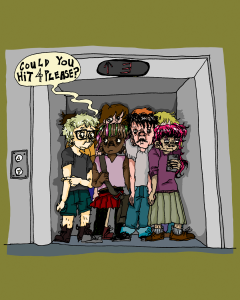Emotional support animals help students handle mental health
February 17, 2020
In the past, humans often relied on a friend or family for moral support, but more than ever, doctors are medically prescribing animals to help individuals dealing with mental illness.
According to the National Alliance of Mental Health, one in five adults living in the U.S. experience mental illness each year. These individuals suffer from depression, stress and anxiety more than anything and sometimes, antidepressants aren’t the right fit.
Senior Maddie Kiousis, a psychology major, said she wanted to try something other than taking prescription pills.
“I believe I was 17 or 18 when I started to experience depression and anxiety. I was going through a lot with family and school, and I knew I needed to find another way of help because I didn’t want to be medicated,” Kiousis said.
Kiousis started seeing a therapist during her first year of college and brought up the idea of an emotional support animal after a few sessions.
“I see a lot of ESA registrations online, but those applications are not real. You must ask for permission from a licensed therapist,” Kiousis said. “And you can’t just walk into an office and say that I need an ESA; that conversation takes time.
Kiousis got her first emotional support animal during her second year of college, and values the experience so far.
According to U.S. Service Animals, emotional support animals help individuals with emotional disabilities by providing comfort and support. Kiousis’ ESA is a dog named Luke. Kiousis said that the patient gets to choose the type of animal they want, as long as the animal isn’t out of the norm like a lion, leopard or a cheetah.
“One of my friends introduced to me Luke when he was six weeks old. He used to live on a farm in Illinois and his parents were farm dogs,” Kiousis said.
Their relationship, at first, was just like any other dog, until Luke experienced Kiousis’ first incident with her. Kiousis was feeling really anxious that day and nearly broke down crying because of a car accident.
“My car got totaled, and I was really upset about it. That’s when he first showed affection. Over time, he grew in that understanding of knowing when I need him or when we need each other,” Kiousis said.
According to Therapy Pet, ESAs have a profound effect on an individual’s psychological state. ESAs provide comfort and can prevent an individual from feeling isolated and lonely. Spending time with an ESA is known to lower stress levels and reduce an individual’s anxiety.
Elicka Sparks, a professor in the Department of Government and Justice Studies, brings her 3-year-old therapy dog named Ethel to class, and her students admire the love they get from her.
According to the American Kennel Club, therapy dogs are dogs that go with their owners to volunteer in public settings such as schools, hospitals or nursing homes.
“Some students stay after class to pet her. I had one student last semester who started crying when she petted her. That student was seeking comfort, it was an opening for me to be supportive through whatever they might be going through,” Sparks said.
Therapy dogs are not service dogs. Therapy dogs work along with their owner to improve the lives of other people.
Sparks is Ethel’s handler, meaning she trains Ethel to behave and not act aggressively toward individuals. As a handler, Sparks recognizes when Ethel needs attention or affection. She also understands that communication is essential when training Ethel.
“My daughter and her husband were dog trainers, and they taught me everything I need to know,” Sparks said.
Sparks always asks for permission before having Ethel in public places.
Sparks said she believes having Ethel in class is a great thing, because she understands that some students have pets at home but can’t bring them to campus for numerous reasons.
Kiousis lives by herself off campus, so having Luke gives her comfort. She also said she feels that Luke pushes her to be more active than she would be on her own.
“It gives me a sense of responsibility, I have to get up out of bed, feed him and take care of someone other than myself,” Kiousis said.
Kiousis has noticed some common misconceptions about ESAs and shared some of those issues.
“I met someone who was rude to me for having Luke. She said ESAs are a bad thing for people who have disabilities. There are some individuals who abuse the system and try to say that their ESA is a service animal when that’s not really true. ESAs and service animals don’t have the same level of training,” said Kiousis.
Kiousis said that ESAs don’t have to be trained, but must possess an intuition of when someone is feeling down.
The U.S. Government is creating stricter laws to prevent some individuals from abusing the system, especially when it comes to traveling. There are some places that only ESAs are prohibited to go, so verification is needed when it comes to traveling.
“Your ESA Letter has to be renewed every six months, and the same procedure follows when it comes to traveling,” Kiousis said. “Registering for an ESA is not just a one-time thing.”
The significance of an ESA and the support provided to individuals is different. Kiousis said she believes that a pet isn’t that different from ESA.
“A pet who doesn’t identify as an ESA will have the same benefits, the only difference is the animal is official,” Kiousis said. “The only thing that matters (is) if the person feels safe and secure with their ESA, and that’s what I feel whenever I’m around Luke.”













Art Miedzinski • May 14, 2020 at 6:49 pm
We are in vet housing, can’t do much physically and emotionally, and are married.As a couple, we would like a vacation in 15 years; if it means paying for animals, we will. It is hard to get letters because system is in transition. Easier to pay when pets are still allowed, but we will try not to accept cargo travel; keep them in cabin!